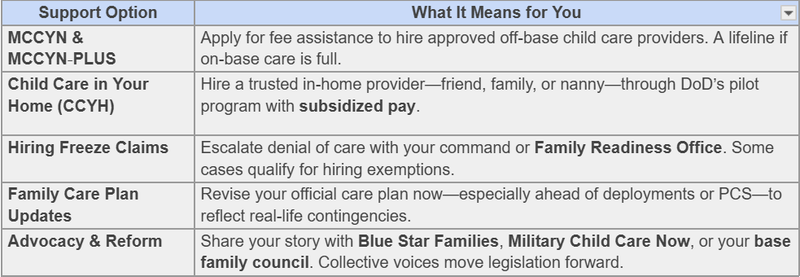MILITARY READINESS UNDERMINED BY CHILDCARE CRISIS

ADVERTISEMENT
Military families are trained to adapt. We serve, move, adjust, and overcome. But no level of resilience can solve a problem this big alone: our nation’s military childcare system is in crisis.
Behind every mission-ready unit is a family doing everything it can to hold the line. But when child care fails, readiness fails. And right now, families across every branch are being forced to make impossible choices—the mission or their kids.
Military Childcare Crisis: System at Breaking Point
The Department of Defense operates the largest employer-sponsored childcare program in the country—serving over 160,000 military children at nearly 750 installations. But the system is overwhelmed:
- 6,200+ staff vacancies are leaving classrooms empty and centers under capacity.
- Waitlists stretch for months or years, especially for infant and toddler care.
- Turnover is rampant—50% annually for Army CDCs—making consistent, quality care nearly impossible.
In 2025, an unexpected DoD hiring freeze undid years of progress. Air Force waitlists surged from under 3,000 in late 2024 to over 4,000 children in early 2025, and at least one base had to close an infant classroom due to short staffing.
Nobody Prepared You for Military Life
But we can help. Join over 100k spouses already getting the advice, resources, and military tea they need to thrive.
Real Families, Real Consequences
At Peterson Space Force Base, a mother had secured care for her twins—only to lose both spots weeks before they were set to start. With no backup options, she was forced to resign and pivot to remote work.
This story echoes across the country. A RAND survey showed those who do manage to find military childcare often spend over 15% of their income on it—more than twice the federal affordability benchmark of 7%.
These are not isolated incidents—they’re system-wide failures that are directly impacting careers, health, mental well-being, and mission readiness.
Mission Impact
When childcare fails, service members can’t serve. Single parents face tough choices, PCS becomes chaos, and spouse careers stall mid-assignment.
A national poll found 93% of Americans support federal childcare relief for military families, and 91% back stipends for spouses entering the workforce after a move according to bluestarfam.org.
As GAO recommends, the Air Force and Marines need continuous needs assessment and childcare workforce tracking; DOD has committed to implementing these improvements.
Service Members and Spouses: Childcare Concerns
Here is what servicemembers and spouses have to say about this ongoing crisis.
ADVERTISEMENT
Erin, Army officer at Fort Campbell
“Childcare is the only thing that has made me consider leaving military service… the logistics and constant stress that come from childcare is truly the hardest thing I’ve had to deal with.”
Ashley, Military Spouse
"As a first-time mom and a fairly new military spouse, I wasn't entirely sure what to expect in a cross-country move in addition to the childcare situation, and I don't think I totally understood the severity of the childcare situation or the shortage and the waitlists."
Chelsea, Military Spouse (Special Forces)
"You feel like, am I failing my guys at that point as a squad leader? Am I causing them hardship while trying to take care of my family as well? Because they're both your family. They're just different families.”
ADVERTISEMENT
DoD Childcare Initiatives: Current Efforts and Gaps
The FY25 National Defense Authorization Act (NDAA) includes key reforms:
- Off-base childcare fee assistance is now fully funded.
- Spouses looking for work have care eligibility extended from 90 to 180 days.
- Pay and incentives for childcare workers have improved to address retention.
And the Childcare Expansion Initiative (launched June 2025) is bringing new capacity:
- Building 200-child centers in high-need locations like San Diego, Hawaii, Colorado Springs, and Norfolk.
- Expanding Military Childcare in Your Neighborhood PLUS (MCCYN‑PLUS) to increase access for off-base families.
These are steps in the right direction—but they are not yet reaching families fast enough.
Readiness Has a Weak Link—and It’s Homefront Support
Every policy memo and legislative vote must be measured against one reality: If military parents don’t have care, they can’t report for duty.
And when one member of the family is forced to step back, both the mission and the household suffer.
From missed deployments to stalled careers, from reduced household income to mental health strain—the ripple effects are massive.
It’s no surprise that 93% of Americans support federal childcare relief for military families, and 91% favor stipends for spouses re-entering the workforce after a move (Blue Star Families, 2024).
Immediate Actions for Military Families Facing Childcare Issues
You can’t wait for a broken system to catch up—but you’re not powerless.
Here are resources and actions you can take today:

This crisis will not fix itself. It demands leadership, funding, and urgency. But it also requires something just as powerful: your voice.
If you are struggling to access care, you’re not alone. If you’ve had to leave a job, delay a deployment, or make impossible decisions for your family—you are not failing; the system is.
Use your command channels. Use your community. Use your voice.
ADVERTISEMENT
Collaborative Solutions for Military Childcare Challenges
We stand by our service members. Let’s stand by their families too.
Because readiness starts at home, and child care is not just a benefit—it’s a battle rhythm.
If you need help navigating options, filing an exemption, or want to take action through advocacy, there is support for you. Ask for:
- A customized letter template to your base commander or elected official
- Step-by-step instructions to apply for child care fee assistance
- Support to connect with advocacy organizations amplifying your voice
Suggested reads:
BY NATALIE OLIVERIO
Veteran & Senior Contributor, Military News at MilSpouses
Natalie Oliverio is a Navy Veteran, journalist, and entrepreneur whose reporting brings clarity, compassion, and credibility to stories that matter most to military families. With more than 100 published articles, she has become a trusted v...
- Navy Veteran
- 100+ published articles
- Veterati Mentor
ADVERTISEMENT
ADVERTISEMENT




